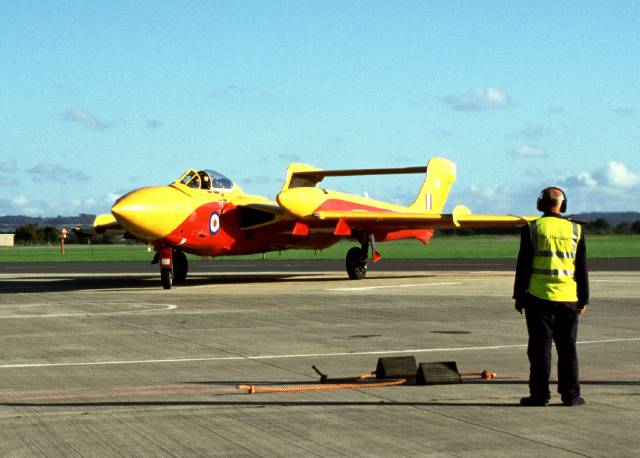|
|


 All images on this page © the author.
All images on this page © the author.
|
These pictures were taken at RNAS Yeovilton on September 29 2001 at a reunion open to all ex-Sea Vixen fliers, maintenance crews and partners. There were also some aviation enthusiasts in attendance.
|

Taxying in.
Dynax 7 and Sigma 50-500mm on Provia 400F at ISO 800, transparency scan at 2820 dpi
|
|
Turning to port with the assistance of a little extra thrust and nosewheel steering, note the position of the nosewheel. This latter feature was one of the important additions to naval aircraft of the era to aid manoevering such a large aircraft on a crowded, moving flight deck at sea. Differential braking, as used by Hunter and Canberra aircraft was quite difficult to master as I discovered once in a Hunter whilst out with a pilot doing a compass swing. It was quite interesting watching Canberras using differential braking to negotiate the sharp corners, and narrow taxy-ways, as they taxied from the runway to a hardstanding at Lee-on-Solent during the 1970s.
|

Almost there.
Dynax 7 and Sigma 50-500mm on Provia 400F at ISO 800, transparency scan at 2820 dpi
|
|
The absence of any marshalling hand signals from the ground crew member was distinctly different to the behaviour exhibited by naval ratings 'seeing in' aircraft whilst in FAA service. At this time the marshaller would have both arms raised, with fingers extended and palms backwards, working in a kind of repeat wing fold type movement to indicate continuing movement forward. For a turn then one arm would be extended horizontaly, pointing in the direction of the turn, whilst the other continued the wave on. As the aircraft reached the halt point both arms would be raised and the fists clenched to indicate 'on brakes'. There were additional signals to indicate up flaps and up hook. With the introduction of the RN Phantom new signals were evolved to indicate nose leg extend (40 inches) and shrink.
Another 'interesting' experience I had whilst on 'Crash and Smash' was whilst attending a Sea Venom with a burst nose wheel tyre. Our team were in the process of jacking up the nose of the Venom, so as to fit a special ground-use-only substitute, which had come to rest left of centre of the main runway. Suddenly the noise of an approaching Vixen seemed a little to close. It was! The Vixen was actually landing on and we all dived off to the left of the runway as this Vixen hurtled past with inches to spare. I bet the ATCO's face became a delicate shade of puce which would have contrasted nicely with our sudden, uncharacteristic, pallor
|

|
Feel free to e-mail me with any comments and feedback. |
|


|


